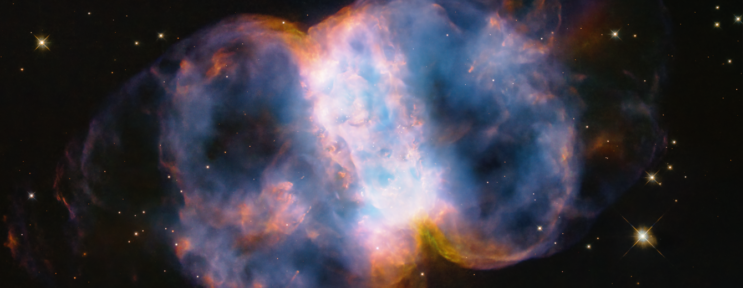5 min read
Hubble Celebrates 34th Anniversary with a Look at the Little Dumbbell Nebula
In celebration of the 34th anniversary of the launch of NASA’s legendary Hubble Space Telescope on April 24, astronomers took a snapshot of the Little Dumbbell Nebula (also known as Messier 76, M76, or NGC 650/651) located 3,400 light-years away in the northern circumpolar constellation Perseus. The photogenic nebula is a favorite target of amateur astronomers.

M76 is classified as a planetary nebula, an expanding shell of glowing gases that were ejected from a dying red giant star. The star eventually collapses to an ultra-dense and hot white dwarf. A planetary nebula is unrelated to planets, but have that name because astronomers in the 1700s using low-power telescopes thought this type of object resembled a planet.
M76 is composed of a ring, seen edge-on as the central bar structure, and two lobes on either opening of the ring. Before the star burned out, it ejected the ring of gas and dust. The ring was probably sculpted by the effects of the star that once had a binary companion star. This sloughed off material created a thick disk of dust and gas along the plane of the companion’s orbit. The hypothetical companion star isn’t seen in the Hubble image, and so it could have been later swallowed by the central star. The disk would be forensic evidence for that stellar cannibalism.
The primary star is collapsing to form a white dwarf. It is one of the hottest stellar remnants known at a scorching 250,000 degrees Fahrenheit, 24 times our Sun’s surface temperature. The sizzling white dwarf can be seen as a pinpoint in the center of the nebula. A star visible in projection beneath it is not part of the nebula.
Pinched off by the disk, two lobes of hot gas are escaping from the top and bottom of the “belt,” along the star’s rotation axis that is perpendicular to the disk. They are being propelled by the hurricane-like outflow of material from the dying star, tearing across space at two million miles per hour. That’s fast enough to travel from Earth to the Moon in a little over seven minutes! This torrential “stellar wind” is plowing into cooler, slower-moving gas that was ejected at an earlier stage in the star’s life, when it was a red giant. Ferocious ultraviolet radiation from the super-hot star is causing the gases to glow. The red color is from nitrogen, and blue is from oxygen.
Given our solar system is 4.6 billion years old, the entire nebula is a flash in the pan by cosmological timekeeping. It will vanish in about 15,000 years.
Hubble’s Star Trekking
Since its launch in 1990 Hubble has made 1.6 million observations of over 53,000 astronomical objects. To date, the Mikulski Archive for Space Telescopes at the Space Telescope Science Institute in Baltimore, Maryland holds 184 terabytes of processed data that is science-ready for astronomers around the world to use for research and analysis. Since 1990, 44,000 science papers have been published from Hubble observations. The space telescope is the most scientifically productive space astrophysics mission in NASA history. The demand for using Hubble is so high it is currently oversubscribed by a factor of six-to-one.
Most of Hubble’s discoveries were not anticipated before launch, such as supermassive black holes, the atmospheres of exoplanets, gravitational lensing by dark matter, the presence of dark energy, and the abundance of planet formation among stars.
Hubble will continue research in those domains and capitalize on its unique ultraviolet-light capability on such topics as solar system phenomena, supernovae outbursts, composition of exoplanet atmospheres, and dynamic emission from galaxies. And Hubble investigations continue to benefit from its long baseline of observations of solar system objects, stellar variable phenomena and other exotic astrophysics of the cosmos.
NASA’s James Webb Space Telescope was designed to be meant to be complementary to Hubble, and not a substitute. Future Hubble research also will take advantage of the opportunity for synergies with Webb, which observes the universe in infrared light. The combined wavelength coverage of the two space telescopes expands on groundbreaking research in such areas as protostellar disks, exoplanet composition, unusual supernovae, cores of galaxies and chemistry of the distant universe.
Credit: NASA’s Goddard Space Flight Center; Lead Producer: Paul Morris
The Hubble Space Telescope has been operating for over three decades and continues to make ground-breaking discoveries that shape our fundamental understanding of the universe. Hubble is a project of international cooperation between NASA and ESA (European Space Agency). NASA’s Goddard Space Flight Center in Greenbelt, Maryland, manages the telescope and mission operations. Lockheed Martin Space, based in Denver, Colorado, also supports mission operations at Goddard. The Space Telescope Science Institute in Baltimore, Maryland, which is operated by the Association of Universities for Research in Astronomy, conducts Hubble science operations for NASA.
Media Contact:
Claire Andreoli
NASA’s Goddard Space Flight Center, Greenbelt, MD
claire.andreoli@nasa.gov
Ray Villard
Space Telescope Science Institute, Baltimore, MD









